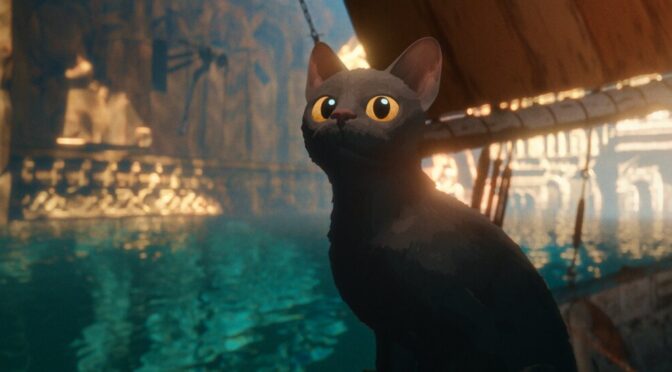FLOW is a beautiful voyage that invites as many questions as it offers answers. A dialogue-free animation that cuts across languages and travels to familiar yet new realms, Gints Zilbalodis’ film is a pure and expressive picture, with profound depths beneath the glimmering surface.
The film follows the voyage of a black cat whose homeland – devoid of humans, but not their architecture and landmarks – experiences a flood of biblical extent. The cat finds refuge on a small boat, joined not by the pairs of animals that famously board Noah’s Ark but by a motley collection of creatures – capybara, secretary bird, lemur, dog – who previously feared each other at worst and tolerated each other at best. They sail for a stone pillar formation in the far distance, encountering other creatures in the landscape, adapting, and experiencing dreams and nightmares of the world they now find themselves in.
The setting of FLOW evokes a fable-like atmosphere, with the world removed enough from our reality to be symbolic but familiar enough to resonate. As the cat and its companions traverse this world, there are remnants of humanity but no humans: a made bed; wood carvings of animals; the ruins of an antiquated civilisation; and the very boat the animals undertake their voyage in. It leaves more questions than answers and invites us to consider whether this absence and the subsequent flood are of man’s own making and how long this mere echo of humanity has reverberated. In that regard, the animals’ journey – both literal and emotional – offers the core of the adventure and a thematic underpinning to complement the visual beauty of the animation.
“…the animals’ journey – both literal and emotional – offers the core of the adventure and a thematic underpinning to complement the visual beauty of the animation.”
That beauty is the first thing that will register as FLOW and its dramatic flood wash over you. Sequences live up to the film’s title and glide through scenes, gently bringing in other elements as the view reveals characters and settings gracefully. The virtual camera drops elegantly from the cat’s original home, through a broken window pane, to ground level before the rising water level encroaches from the background into the action. The long takes have some video game qualities to their motion; a lack of flashiness intended to give a sense of space rather than a chest-puffing display of craft that is so often the preoccupation of such shots in live-action cinema. However, FLOW also shows kineticism where required: an early chase scene with a pack of dogs is rapid and frenetic. The film’s aesthetics display that same range of modes; sunlit shots of the cat wandering the grounds near its home have a calming beauty, whereas a nightmare sequence with an entrancing circle of imposing deer strikes anxiety into the heart.
The animal characters are carefully animated, with Zilbalodis and team conveying emotional engagement despite the lack of dialogue typical of more mainstream child-focused animation. The cat and other animals are anthropomorphic to just the correct degree; the animation clearly heightens the expressions and moods of the creatures from anything resembling zoological reality, yet they never feel emotionally dishonest. In keeping with the dreamlike quality of the entire piece, it finds the same kernel of truth that a fuzzy memory of a beloved pet might have – exaggerated by memory’s fallibility but with emotional authenticity.
“…[the animation] finds the same kernel of truth that a fuzzy memory of a beloved pet might have – exaggerated by memory’s fallibility but with emotional authenticity.”
The disparate bunch of creatures finding solidarity in the face of an ecological crisis has some clear overtures towards the animosity found among the film’s very real human viewers. The animals learn from each other and grow to tolerate and even accept one another, but the variance in species means they never surrender their unique identities. They must find a way to survive an ecological shock that disrupts the natural rhythms of their existence. It’s a profound thing to see in what is an otherwise reasonably prosaic setup on paper – a motley bunch of animals – found in more comedic and mainstream features from ICE AGE through MADAGASCAR to ZOOTOPIA.
The unique approach of FLOW streams through the entire feature, from its animation style to character behaviour, in a way that deepens the impact of its themes of solidarity, companionship, and harmony. The film will easily carry viewers along with the current, using a remarkable blend of calm and beauty.

